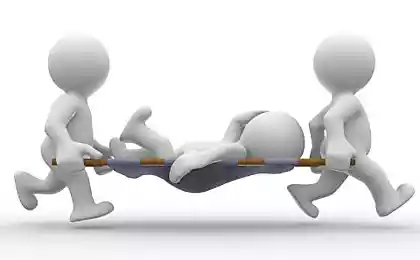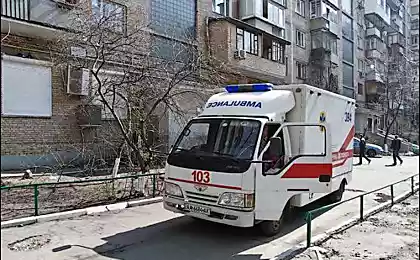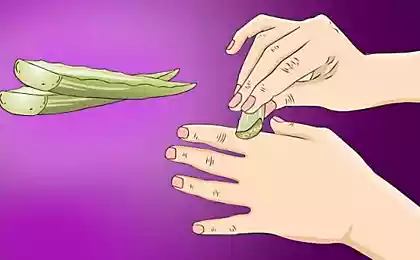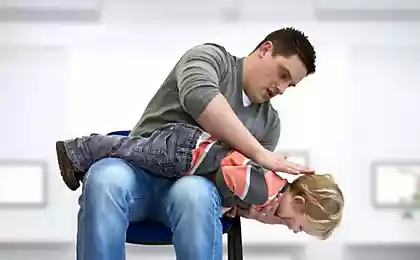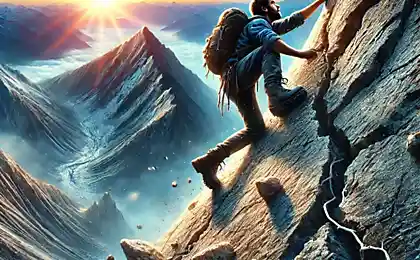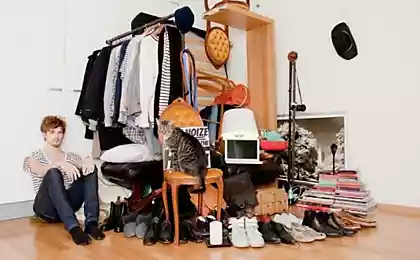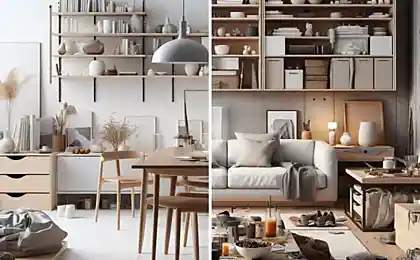288
First Aid Mistakes: 12 Things You Should NOT Do
First aid should be provided quickly and correctly. And both words are key here: sometimes delaying death is like, and sometimes it is better to do nothing than make mistakes at first aid and harm.
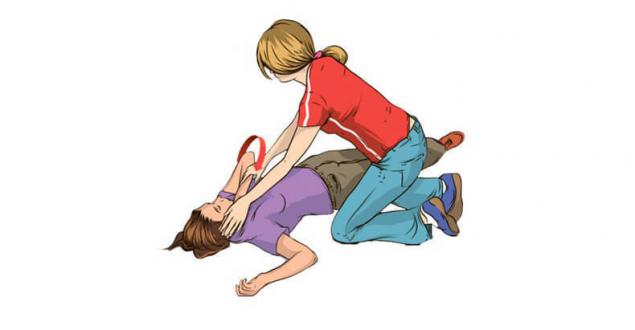
Why doesn’t everything go smoothly with first aid? It is usually done by non-professionals. We’ve all heard of harnesses, bandages, and tires, but quite often we have some rough information about how and when to use them. As a result, tourniquets are applied for several hours, and indirect heart massage is carried out directly along the broken ribs of the victim in an accident.
1. Excessive stirring

Remember: victims in an accident and fallen from a height before the arrival of the ambulance can be touched only if where they lie, it is dangerous to be physically (burning house or car, tilted tree, incoming water, etc.). The rule “don’t move or turn over the victim without vital necessity” is written in blood and ink, which translates the terrible word “disability”. Suffice it to say that rescuers sometimes prefer to disassemble the car around the victim than forcibly pull it out of there.
It is also not necessary to once again pull people with suspected heart attack or stroke. Such a person should not go to the hospital on his two with support, he should be carried on a stretcher. Otherwise, the “truck” can be very expensive.
2. Remediation of dislocations
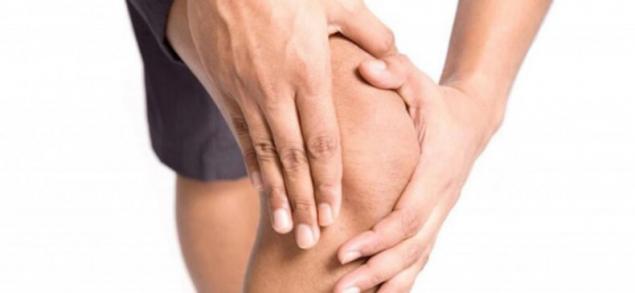
You are 100% sure that the victim has a dislocation, and you are going to correct it. Stop it! Ask yourself a simple question: Are your eyes capable of emitting X-rays? If the answer is yes, go to the Nobel Committee or the nearest mental hospital. In other cases (in conditions other than the taiga or desert) it is impossible to adjust independently what looks like a dislocation. Because even an experienced doctor will not dare to determine such an eye injury. Adequate actions in such a situation: immobilize the injured limb, call an ambulance and go to the emergency room.
Now for immobilization. Tyre-laying is not putting a broken hand on a straight stick. If you decide to apply an improvised tire, keep in mind: the limb cannot be straightened forcibly! It is taped as is - in the current most convenient position for the victim so that not only the fracture site, but also two, and in some cases three nearest joints are immobilized.
3. Unskillful harnessing
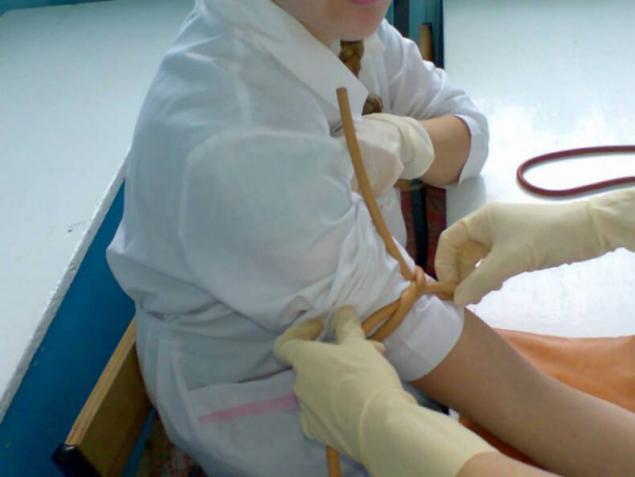
When stopping bleeding by applying a tourniquet (starting with “not there” and ending with “for a long time”), so many mistakes are made that many experts call for limiting yourself to just a tight bandage, bending the limb in the joint that is above the affected vessel, or tamponing the wound tightly. In most cases, this is enough. They do not change the dressings, but put one on the other. Arriving doctors on them will be able to quickly assess blood loss. Mistakes in first aid are inadmissible in any case.
Well, if we are talking about the most terrible arterial bleeding, do not waste precious time looking for a tourniquet. As soon as possible, press the fountain of scarlet blood with your fingers, otherwise a person may not live until the moment of applying knowledge on touring.
Even in the case of arterial bleeding, we remember that the estimated time for applying the tourniquet is no more than 1 hour in winter and 1.5-2 hours in summer. And it is better, regardless of the time of year, to dissolve the tourniquet every 20 minutes, so that then the victim does not “thank” for the lost limb.
4. Stop bleeding from the nose by rolling back the head
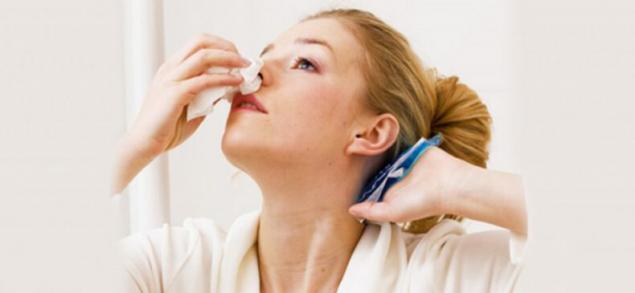
If you throw your head back, the blood from the nose will cease to flow. Will the bleeding stop? Nope. It'll just drain blood into the nasopharynx and then into the stomach. It seems like nothing fatal, but first of all, we don't see if the bleeding continues or not. And secondly, there is such an unpleasant thing as bloody vomiting.
With nosebleeds, adequate help: slightly tilt the victim's head forward, stamp the nostrils with a clean napkin or wool soaked in hydrogen peroxide, and then find out the cause of the incident.
5. Hypothesis therapy
11092
This is the most “weighty” item of the program, because, despite the direct prohibitions of doctors “this medicine is prescribed only to you, do not advise it to anyone”, in our culture, it is customary to recommend drugs for internal use, based on the magical method of analogy – “if I or someone else in this situation helped, then ...”. Well, that doesn't mean anything!
If a person is unwell, do not offer them medications that help in a similar situation. First, it is not at all true that similar external symptoms are caused by the same problem. Secondly, drugs have features of use, contraindications and side effects that are not obvious to people without medical education.
The most common “drug” mistake is to offer nitroglycerin to anyone holding onto the chest. The consequences of such assistance could be worse than imagined, to the point of dramatically reducing pressure to critical levels. The only exception: the victim himself asks for a certain drug or inhaler. In this case, most likely, he is chronicle and has recommendations from the attending physician.
6. Artificial vomiting in cases where it should not be allowed

In case of poisoning, it is usually advised to induce vomiting from the victim. However, this is categorically impossible to do in case of suspected poisoning with acid, alkali and other caustic substances. If vomiting is justified, then you do not need to use permanganate, soda, etc. on your own. All you need is a lot of warm water.
7. His mouth is filled with falsehood.
Most often, epilepsy suffers from the forced insertion of something into the teeth. From spoons, screwdrivers and even knives, with which compassionate citizens try to help with an attack, there is a lot of harm (broken teeth and throat injuries from metal and obstruction of the trachea and bronchi from more fragile objects), and there is usually little sense. Do not hold the epileptic by the arms and legs with all your strength, just slightly support the head to avoid injuries, and when the convulsions subside, turn the person sideways.
8. Burn oil, iodine in wound
Grandmother “smear the burn with oil” has been ingrained in the consciousness of entire generations and is hardly etched even by stubborn grappling “you can’t, you can’t, you can’t.” Neither oil nor all kinds of panthenols can lubricate a fresh burn. Unless, of course, there is a desire to aggravate the situation. Correctly cool the affected area with cold water, but not for a minute or two, but 10-15-20.
Pouring iodine, alcohol and greens into a deep wound is also pointless - it will not bring any benefit. Only harm. In unskillful hands, these substances are needed only to lubricate scratches. Otherwise, the “dummies” are safer to use hydrogen peroxide.
9. Slapping on the back of a choking man
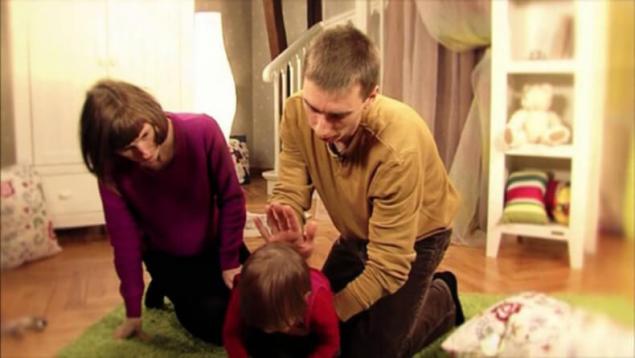
This common way to help a choked person is not the safest. In certain cases, such cottons can contribute to even deeper penetration of a foreign body into the respiratory tract. It is impossible to determine whether this case will fall into the category of dangerous in advance, so the best strategy in this case is for the victim (if possible without panic) to lean forward and make several sharp exhalations. Or they may be able to snatch it from behind under their armpits and press on the solar plexus (not the chest).
10. Ineffective cardiopulmonary resuscitation

The idea of doing indirect heart massage and artificial respiration should be able to everyone, at least this is taught, starting from school. But if you can't, it's better not to take it. If you can, consider a few comments. First, if a person has a beating heart and a pulse is felt, such events are not necessary! Second, it is not necessary to beat all the crap on the sternum and dangerous. Precardial blow inflicted by a layman, most likely, will not bring any benefit, but you can break ribs and cause a lot of injuries.
11. Removing objects from wounds
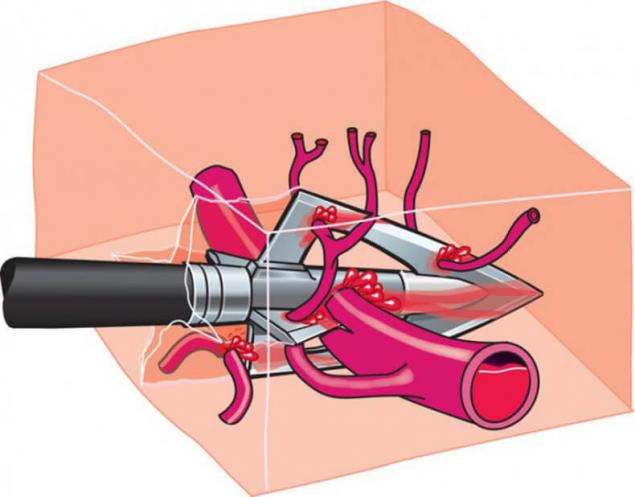
You can get a splinter from a finger, a slightly punctured nail or a fragment of a plate that clearly did not cut the finger in half. But never, in no case can any object be removed from a more or less serious wound. Even if a piece of rusty wire sticks out in a person. If you are worried about an infection - it is too late, the whole infection has long been inside, you can fight it later, unlike bleeding. Doctors "ambulance" not for the uncle of the investigator keeps knives and other foreign things in place until the victim is in the conditions of the deployed operating room. Because in a clean field, on the road or at home, they will have nothing to stop the bleeding that may open after removing the object from the wound, and make up for the blood loss.
No matter how scary a person looks with a knife in his chest, it is absolutely impossible to remove it yourself.
12. Alcohol therapy
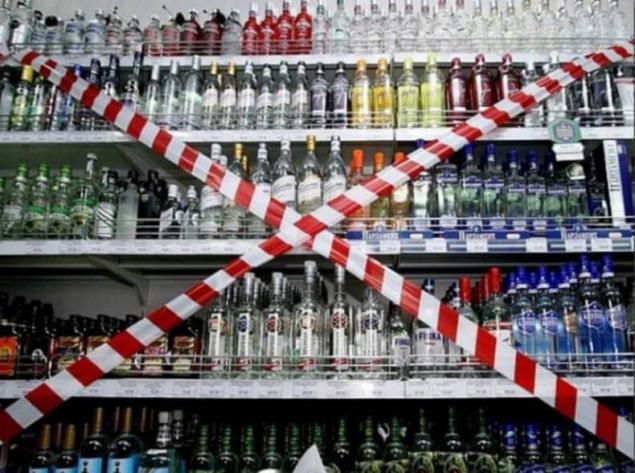
Alcohol analgesia has entered the folklore stronger than I would like. Before offering someone cognac for anesthesia or snow, it is better to look for other options for assistance or refrain from it altogether. First, in drunken fever, pain sensitivity changes, and this is excessive movement during fractures and difficulty in making a diagnosis. Secondly, most drugs are not designed for simultaneous administration with alcohol. Not to mention the fact that a drunk patient is a nightmare of a doctor who needs to be pacified and treated at the same time.
Findings
In general, providing first aid is sometimes dangerous – it can be harmful. In the United States, there is a Good Samaritan law, according to which a person who provides first aid in an emergency cannot then be dragged to court for possible harm. There have been cases.
Does this mean that you should leave the fallen to their fate, leave the bleeding and remain indifferent to the misfortune of others? Of course not. Another thing is that your actions should always be measured with competence. And also carefully listen to what is taught on OBJ and take first aid courses. They are offered by the Ministry of Emergency Situations, the Red Cross, driving schools, tourist clubs and many other organizations. published
Read also:
5 First Aid Skills Everyone Needs to Know
She wrapped her toes with a Band-Aid. Having learned the power of this technique, I always do it!
P.S. And remember, just changing our consumption – together we change the world!
Join us on Facebook, VKontakte, Odnoklassniki
Source: cmtscience.com/

Why doesn’t everything go smoothly with first aid? It is usually done by non-professionals. We’ve all heard of harnesses, bandages, and tires, but quite often we have some rough information about how and when to use them. As a result, tourniquets are applied for several hours, and indirect heart massage is carried out directly along the broken ribs of the victim in an accident.
1. Excessive stirring

Remember: victims in an accident and fallen from a height before the arrival of the ambulance can be touched only if where they lie, it is dangerous to be physically (burning house or car, tilted tree, incoming water, etc.). The rule “don’t move or turn over the victim without vital necessity” is written in blood and ink, which translates the terrible word “disability”. Suffice it to say that rescuers sometimes prefer to disassemble the car around the victim than forcibly pull it out of there.
It is also not necessary to once again pull people with suspected heart attack or stroke. Such a person should not go to the hospital on his two with support, he should be carried on a stretcher. Otherwise, the “truck” can be very expensive.
2. Remediation of dislocations

You are 100% sure that the victim has a dislocation, and you are going to correct it. Stop it! Ask yourself a simple question: Are your eyes capable of emitting X-rays? If the answer is yes, go to the Nobel Committee or the nearest mental hospital. In other cases (in conditions other than the taiga or desert) it is impossible to adjust independently what looks like a dislocation. Because even an experienced doctor will not dare to determine such an eye injury. Adequate actions in such a situation: immobilize the injured limb, call an ambulance and go to the emergency room.
Now for immobilization. Tyre-laying is not putting a broken hand on a straight stick. If you decide to apply an improvised tire, keep in mind: the limb cannot be straightened forcibly! It is taped as is - in the current most convenient position for the victim so that not only the fracture site, but also two, and in some cases three nearest joints are immobilized.
3. Unskillful harnessing

When stopping bleeding by applying a tourniquet (starting with “not there” and ending with “for a long time”), so many mistakes are made that many experts call for limiting yourself to just a tight bandage, bending the limb in the joint that is above the affected vessel, or tamponing the wound tightly. In most cases, this is enough. They do not change the dressings, but put one on the other. Arriving doctors on them will be able to quickly assess blood loss. Mistakes in first aid are inadmissible in any case.
Well, if we are talking about the most terrible arterial bleeding, do not waste precious time looking for a tourniquet. As soon as possible, press the fountain of scarlet blood with your fingers, otherwise a person may not live until the moment of applying knowledge on touring.
Even in the case of arterial bleeding, we remember that the estimated time for applying the tourniquet is no more than 1 hour in winter and 1.5-2 hours in summer. And it is better, regardless of the time of year, to dissolve the tourniquet every 20 minutes, so that then the victim does not “thank” for the lost limb.
4. Stop bleeding from the nose by rolling back the head

If you throw your head back, the blood from the nose will cease to flow. Will the bleeding stop? Nope. It'll just drain blood into the nasopharynx and then into the stomach. It seems like nothing fatal, but first of all, we don't see if the bleeding continues or not. And secondly, there is such an unpleasant thing as bloody vomiting.
With nosebleeds, adequate help: slightly tilt the victim's head forward, stamp the nostrils with a clean napkin or wool soaked in hydrogen peroxide, and then find out the cause of the incident.
5. Hypothesis therapy
11092
This is the most “weighty” item of the program, because, despite the direct prohibitions of doctors “this medicine is prescribed only to you, do not advise it to anyone”, in our culture, it is customary to recommend drugs for internal use, based on the magical method of analogy – “if I or someone else in this situation helped, then ...”. Well, that doesn't mean anything!
If a person is unwell, do not offer them medications that help in a similar situation. First, it is not at all true that similar external symptoms are caused by the same problem. Secondly, drugs have features of use, contraindications and side effects that are not obvious to people without medical education.
The most common “drug” mistake is to offer nitroglycerin to anyone holding onto the chest. The consequences of such assistance could be worse than imagined, to the point of dramatically reducing pressure to critical levels. The only exception: the victim himself asks for a certain drug or inhaler. In this case, most likely, he is chronicle and has recommendations from the attending physician.
6. Artificial vomiting in cases where it should not be allowed

In case of poisoning, it is usually advised to induce vomiting from the victim. However, this is categorically impossible to do in case of suspected poisoning with acid, alkali and other caustic substances. If vomiting is justified, then you do not need to use permanganate, soda, etc. on your own. All you need is a lot of warm water.
7. His mouth is filled with falsehood.
Most often, epilepsy suffers from the forced insertion of something into the teeth. From spoons, screwdrivers and even knives, with which compassionate citizens try to help with an attack, there is a lot of harm (broken teeth and throat injuries from metal and obstruction of the trachea and bronchi from more fragile objects), and there is usually little sense. Do not hold the epileptic by the arms and legs with all your strength, just slightly support the head to avoid injuries, and when the convulsions subside, turn the person sideways.
8. Burn oil, iodine in wound
Grandmother “smear the burn with oil” has been ingrained in the consciousness of entire generations and is hardly etched even by stubborn grappling “you can’t, you can’t, you can’t.” Neither oil nor all kinds of panthenols can lubricate a fresh burn. Unless, of course, there is a desire to aggravate the situation. Correctly cool the affected area with cold water, but not for a minute or two, but 10-15-20.
Pouring iodine, alcohol and greens into a deep wound is also pointless - it will not bring any benefit. Only harm. In unskillful hands, these substances are needed only to lubricate scratches. Otherwise, the “dummies” are safer to use hydrogen peroxide.
9. Slapping on the back of a choking man

This common way to help a choked person is not the safest. In certain cases, such cottons can contribute to even deeper penetration of a foreign body into the respiratory tract. It is impossible to determine whether this case will fall into the category of dangerous in advance, so the best strategy in this case is for the victim (if possible without panic) to lean forward and make several sharp exhalations. Or they may be able to snatch it from behind under their armpits and press on the solar plexus (not the chest).
10. Ineffective cardiopulmonary resuscitation

The idea of doing indirect heart massage and artificial respiration should be able to everyone, at least this is taught, starting from school. But if you can't, it's better not to take it. If you can, consider a few comments. First, if a person has a beating heart and a pulse is felt, such events are not necessary! Second, it is not necessary to beat all the crap on the sternum and dangerous. Precardial blow inflicted by a layman, most likely, will not bring any benefit, but you can break ribs and cause a lot of injuries.
11. Removing objects from wounds

You can get a splinter from a finger, a slightly punctured nail or a fragment of a plate that clearly did not cut the finger in half. But never, in no case can any object be removed from a more or less serious wound. Even if a piece of rusty wire sticks out in a person. If you are worried about an infection - it is too late, the whole infection has long been inside, you can fight it later, unlike bleeding. Doctors "ambulance" not for the uncle of the investigator keeps knives and other foreign things in place until the victim is in the conditions of the deployed operating room. Because in a clean field, on the road or at home, they will have nothing to stop the bleeding that may open after removing the object from the wound, and make up for the blood loss.
No matter how scary a person looks with a knife in his chest, it is absolutely impossible to remove it yourself.
12. Alcohol therapy

Alcohol analgesia has entered the folklore stronger than I would like. Before offering someone cognac for anesthesia or snow, it is better to look for other options for assistance or refrain from it altogether. First, in drunken fever, pain sensitivity changes, and this is excessive movement during fractures and difficulty in making a diagnosis. Secondly, most drugs are not designed for simultaneous administration with alcohol. Not to mention the fact that a drunk patient is a nightmare of a doctor who needs to be pacified and treated at the same time.
Findings
In general, providing first aid is sometimes dangerous – it can be harmful. In the United States, there is a Good Samaritan law, according to which a person who provides first aid in an emergency cannot then be dragged to court for possible harm. There have been cases.
Does this mean that you should leave the fallen to their fate, leave the bleeding and remain indifferent to the misfortune of others? Of course not. Another thing is that your actions should always be measured with competence. And also carefully listen to what is taught on OBJ and take first aid courses. They are offered by the Ministry of Emergency Situations, the Red Cross, driving schools, tourist clubs and many other organizations. published
Read also:
5 First Aid Skills Everyone Needs to Know
She wrapped her toes with a Band-Aid. Having learned the power of this technique, I always do it!
P.S. And remember, just changing our consumption – together we change the world!
Join us on Facebook, VKontakte, Odnoklassniki
Source: cmtscience.com/
